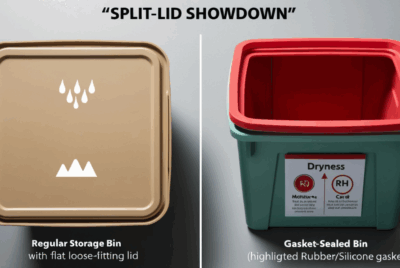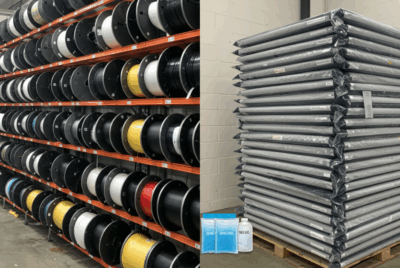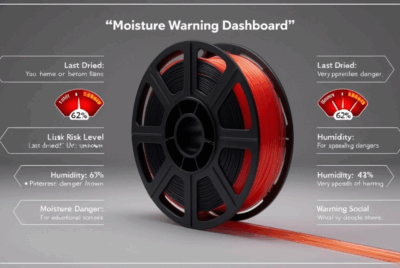What’s the best way to store filament spools that are rarely used?
1. The Forgotten Spools in the Back
We all have them—rarely used filament spools.
Maybe it’s that glow-in-the-dark PLA you bought on a whim, or that Nylon spool for a project you never started.
They sit quietly on the shelf… for months.
But are they still safe to use when you finally need them?
Let’s explore the best ways to store rarely used filament spools so they don’t go bad while you wait.
2. Why Rarely Used Filament Still Needs Protection
Even when you’re not using it, filament absorbs moisture.
Over time, that leads to:
- Brittle or gummy texture
- Poor print quality
- Bubbles and popping in the hot end
- Cracked or stringy layers
You can’t just toss a spool in a box and forget it. It needs long-term care.
3. Common Risks When Filament Sits for Months
- Humidity: The #1 enemy
- Temperature swings: Cause condensation in sealed bins
- Sunlight: UV breaks down plastic and fades color
- Dust & debris: Can contaminate filament and your nozzle
Storage issues get worse the longer filament sits idle.
4. Rule #1: Always Store Filament Dry
This is non-negotiable.
Whether you’re using a vacuum bag, airtight bin, or dry box, low humidity is key.
Ideal RH range:
| Filament Type | Ideal RH for Storage |
|---|---|
| PLA / ABS | < 40% RH |
| PETG / TPU | < 30% RH |
| Nylon / PVA | < 20% RH |
5. Vacuum-Sealing: The Best Long-Term Storage Method
Vacuum sealing is your best option for rarely used spools.
✅ Blocks moisture
✅ Compact and stackable
✅ Works with silica gel
✅ Easy to label and date
You can use:
- eSun Vacuum Bags
- Geryon Vacuum Sealer Kit
- Ziploc-style hand pump kits (budget-friendly)
6. Should You Dry It Before Storing?
Yes. Always.
Storing a damp spool in a sealed bag just traps the problem inside.
Dry it first using:
- SUNLU S2 or PrintDry Pro (for easy drying)
- Oven at 50–60°C for 4–6 hours (for cautious DIYers)
Then seal it immediately while dry.
7. How to Use Desiccants for Backup Spools
Every vacuum bag or bin should have:
- Silica gel packs (color-indicating is best)
- Change or recharge them every few months
- Store extra packs in an airtight jar so they stay dry
Pro tip: Add a humidity indicator card to make visual checks easy.
8. Storage Containers That Actually Work
If vacuum-sealing isn’t your thing, try:
| Container | Pros | Cons |
|---|---|---|
| Airtight plastic bins | Easy to access & label | Needs desiccant & tight seals |
| Ammo cans | Rugged & moisture-resistant | Heavy & less visual |
| Dry boxes | Print-ready but pricey | Not great for long-term “archive” storage |
| Ziploc freezer bags | Cheap | Less reliable seal over time |
9. Labeling Rarely Used Spools for Future You
Do yourself a favor. Write down:
- Material type
- Brand & color
- Purchase date
- Last dried date
- Notes like “Needs 240°C” or “Moisture-sensitive”
Stick the label inside the bag or tape it to the outside.
10. Should You Separate Rarely Used from Active Filament?
Yes—absolutely.
Keep backup spools in a designated storage zone—so you don’t:
- Constantly open their containers
- Accidentally mix them up with dailies
- Forget which ones were already opened or dried
Rotation systems make this easy (e.g., FIFO = First In, First Out).
11. Where to Store Rare Spools: Location Matters
The best places are:
- Cool: Avoid attics or rooms that get hot in summer
- Dry: Basements are risky unless you use a dehumidifier
- Dark: Avoid direct sunlight or bright fluorescent lighting
Closets, drawers, or cabinets are ideal.
12. How Often Should You Check on Backup Filament?
Every 2–3 months, check:
- Desiccant color
- Vacuum seal status
- RH on your indicator card
Catch problems early—before that $40 specialty spool turns to junk.
13. Should You Re-Dry Before Use Every Time?
If you’re unsure or if it’s been over 3 months, dry the spool before printing.
Even well-stored filament can absorb a bit of moisture when:
- The seal isn’t perfect
- Desiccant is expired
- The container was opened briefly
A quick drying cycle saves hours of troubleshooting.
14. Specialty Filaments That Demand Extra Storage Care
Be extra cautious with:
| Filament | Notes |
|---|---|
| Nylon | Absorbs moisture within hours |
| TPU | Can warp or become stringy |
| PVA | Can dissolve if not stored right |
| Carbon fiber blends | Need stable humidity & temp |
Store these with extra desiccant, vacuum sealing, and tight labeling.
15. Final Thoughts: Treat Rare Spools Like Emergency Supplies
Think of rarely used filament like your emergency chocolate stash.
You want it fresh when you finally reach for it.
✅ Dry it
✅ Seal it
✅ Label it
✅ Check it
With the right setup, even backup filament will perform like new—months (or years) down the road.
❓FAQs
1. How long can filament last in vacuum storage?
PLA can last 1–2 years sealed and dry. Sensitive types like Nylon or TPU: aim to use within 6–12 months.
2. Can I store filament in my garage if it’s sealed?
Not ideal. Extreme temps and condensation are still risks. Better to store indoors.
3. Should I keep the original packaging for rare spools?
Only if it’s vacuum-sealed. Otherwise, reseal it in better long-term packaging.
4. How much silica gel should I use per spool?
Use 50–100g per vacuum bag or bin, depending on container size.
5. Can filament expire even if stored well?
It won’t “expire,” but quality may degrade after years. Always test and dry before use.




